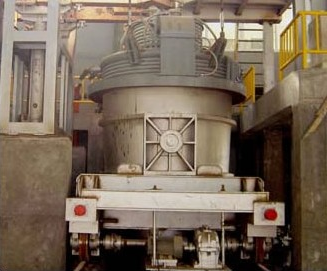MOST ADVANCED TECHNOLOGIES OF LF FURNACE
Single-electrode D.C powering LF ladle furnace
Three-electrode D.C powering LF ladle furnace
Single-electrode arm A.C powering LF ladle furnace
Tubular water-cooled roof
Microcomputer controller-hydraulic electrode regulator
VVVF-motor type electrode regulator
Main Technical Parameters: ( Technical specifications of LF,VOD,VD,type furnaces)
|
Rated capacity t |
Ladle diameter MM |
Transformer rated capacity KVA |
Electrode diameter MM |
Electrode pitch circle diameter MM |
Heating-up rate C/min |
Vacuum pumping rate Kg/h |
Vacuum vessel mm |
Ultimate vacuum Pa |
Ladle weight t |
|
Actual capacity t |
|||||||||
|
20 |
2200 |
3150 |
200 |
500 |
2-3 |
150 |
2800/4100 |
67 |
18 |
|
40 |
2900 |
6300 |
350 |
850 |
2-3 |
250 |
4800/5000 |
67 |
25 |
|
60 |
3100 |
10000 |
350 |
650 |
2-3.5 |
360 |
5300/5500 |
67 |
39 |
|
70 |
3200 |
12500 |
400 |
700 |
2-3.5 |
380 |
5400/5600 |
67 |
43 |
|
100 |
3400 |
18000 |
400 |
700 |
2-3.5 |
400 |
5500/5800 |
67 |
47 |
|
150 |
3900 |
20000 |
450 |
800 |
2-3.5 |
450 |
6300/6600 |
67 |
52 |
Product Specification
Ladle Refining of liquid metal is a proven technology to produce high quality steel. LRF is used to raise the temperature and adjust the chemical composition of molten metal.
Ladle Refining Furnaces (LRFs) are used to desulphurise steel, remove other impurities and hold the molten steel for casting operations. Without LRFs, higher tap temperatures are normally required from steel making furnaces due to heat losses during refining with conventional ladles. Costs of extended furnace time, refractory wear and power/fuel consumption can all be reduced using LRFs to perform holding and refining.
Reduced scrap melting capacity in Basic Oxygen Furnaces (BOF) is another disadvantage of higher tap temperatures. The LRFs also acts as a buffer between the Steel Making Furnace (BOF) or the Electric Arc Furnace (EAF) and the continuous caster, reducing casting costs and allowing greater flexibility in steel making operations.
Process
Ladle Refining Furnaces are used for the following refining processes:
Homogenisation : Temperature and composition are equalized by stirring.
Inclusion Flotation : Non-metallic inclusions can be removed by gentle stirring of the metal. Oxygen levels of 30 parts million (ppm) have been obtained.
Desulphurisation : Synthetic slags can desulphurise from 0.025% to less than 0.015% in about forty minutes. Desulphurisation can also be accomplished by injection of CaSi or fluxes. Generally, 15 kg per ton of a CaO-Al2O3 slag is used.
Vacuum degassing: Hydrogen content can be reduced to 3 ppm.
By providing a mean to refine outside of the steel making furnace, LRFs provide many benefits including reduced alloy consumption, uniform temperature & properties and lower energy costs while increasing overall plant productivity. In addition, a vacuum environment can be attained in LRFs, which allows production of highly refined steels.
DC LRF offers following advantages over similar capacity conventional AC LRF:
1. Less specific power consumption.
2. Lower cost of operation and maintenance.
3. Reduced refractory consumption.
4. Better thermal efficiency.
5. Lesser power requirement compared to conventional LRF.
6. No line flickering.
7. It can also be operated with a weak grid.
8. Small heat size can be treated economically.
Attributes
Special attributes of Electrotherm LRF
Homogenisation: Temperature and composition are equalized by stirring.
Inclusion Flotation: Non-metallic inclusions can be removed by gentle stirring of the metal. Oxygen levels of 30 parts million (ppm) have been obtained.
Desulphurisation: Synthetic slags can desulphurise from 0.025% to less than 0.015% in about forty minutes. Desulphurisation can also be accomplished by injection of CaSi or fluxes. Generally, 15 kg per ton of a CaO-Al2O3 slag is used.
Vacuum degassing: Hydrogen content can be reduced to 3 ppm.
Grain re-structuring of Sulphides and Oxides.
Principles of D.C. Plasma LRF Operation
1. Main objectives of LRF are homogenization of chemical composition & temperature of steel, desulphurisation, removal of inclusions, lowering gas contents, adjusting temperature for tapping and to carry out trimming.
2. The DC Plasma Ladle Furnace operates in the same way as the conventional ladle furnace, but with following differences.
Argon plasma in place of Air plasma
Operation with captive power plant
Easy operation as power supply is short circuit proof
There are only two electrodes
3. Argon injection through drilled graphite electrodes can minimizes arc flare and allows more flexibility in ladle furnace operation.
4. The argon plasma helps to maintain inert atmosphere above the melt decreasing nitrogen, oxygen and hydrogen pick-up.
5. The arc is stable and has a tendency to remain within the concavity around the electrode hole because of the high temperature, thereby reducing radiation loss to the roof and freeboard.
6. Carbon pick up from the electrode can also be decreased, since argon injection provides an extended arc due to the flow resistivity of the argon plasma and low consumption of electrodes.
7. Heating efficiency and ladle refractory life is significantly increased.
8. Use of DC Plasma decreases operational costs due to lower graphite consumption, savings in ferroalloys and power consumption

50t Ladle Refining Furnace (LF)

Refining Furnace






